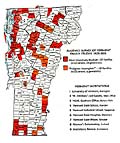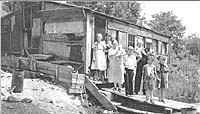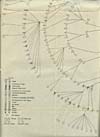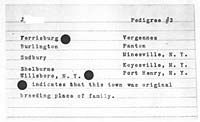

 |
"...I think we can safely say that in the sixty-two families that we have studied..."blood has told," and there is every reason to believe that it will keep right on "telling" in future generations. "Running water purifies itself." The stream of germ-plasm does not seem to." |
 |
Henry F. Perkins |
The search for evidence of "defective germplasm" in poor rural families in Vermont occupied the attention of the Eugenics Survey for the first three years of its existence. Field Investigator Harriett E. Abbott, assisted and succeeded in 1927 by Francis E. Conklin, conducted the vast majority of the "field work," compiled the data, and produced detailed reports and pedigree charts. Full time secretary Anna Rome and student assistants from Professor Perkins' Heredity Class provided clerical support.
Harry Perkins publicized their "findings" in the first two Annual Reports, at professional conferences, and in lectures to his students, women's clubs, church groups, and social organizations. In 1928, Perkins suspended the work on pedigrees of degeneracy, admitting it was "not sufficiently scientific" and had been criticized by his advisors as "placing an undue emphasis on bad heredity." After 1936 he denied both the existence of "pockets of degeneracy" in Vermont and the fact the Survey had initiated these studies to discover them.

Family reputation played a key role in deciding who was studied, what information was solicited, and what conclusions were drawn. Families who had become both visible and "notorious" in the previous decade of child rescue initiatives and poor relief surveys, or in the case files of private charities and state institutions and reformatories, became the unwitting subjects for genealogical study. Families selected were also old Vermont families whose ancestry could be traced back several generations in town records and who bore the stigma of "undesirable citizens" and community rejection.
The families studied fit the stereotype of the "cacogenic
family" (meaning "bad heredity") that had been popularized in rural
sociology and rural eugenics literature since the turn of the century, in which isolation,
illiteracy, poverty, and i nbreeding were the
defining themes. Arthur Estabrook's "Jukes" and "Tribe of Ishmael,"
Florence Danielson's and Charles B. Davenport's "Hill Folk," and Henry Goddard's
"Kallikak Family," provided the research models for the Eugenics Survey's
search for evidence of congenital "feeblemindedness," insanity, criminal or
"asocial" behavior. Families of mixed racial ancestry were particularly
vulnerable to eugenic investigations. The Eugenics Survey case files reveal what is
concealed in most of their publications: the encrypting of racial and ethnic prejudice
within social constructions of inherited mental incompetence as the root cause of
chronic dependency, delinquency, and immorality.
nbreeding were the
defining themes. Arthur Estabrook's "Jukes" and "Tribe of Ishmael,"
Florence Danielson's and Charles B. Davenport's "Hill Folk," and Henry Goddard's
"Kallikak Family," provided the research models for the Eugenics Survey's
search for evidence of congenital "feeblemindedness," insanity, criminal or
"asocial" behavior. Families of mixed racial ancestry were particularly
vulnerable to eugenic investigations. The Eugenics Survey case files reveal what is
concealed in most of their publications: the encrypting of racial and ethnic prejudice
within social constructions of inherited mental incompetence as the root cause of
chronic dependency, delinquency, and immorality.
 Ten
families (the Special Pedigrees Complete) were selected for detailed study of their cost
to the taxpayers in the form of charity and rehabilitation. Of these, at least four were
Native American Abenaki families, whose racial ancestry is identified in Abbott's field
notes and Survey reports as a mixture of "French Canadian, Indian, and Negro."
One family was chosen because its members had been institutionalized in Vermont, New York,
and New Jersey for Huntington's Chorea, a degenerative neurological condition that
geneticists attributed to a dominant gene. Harriett Abbott had created substantial files
on the five families from southwest Vermont in the five years as a child welfare agent prior
to her work for the Eugenics Survey.
Ten
families (the Special Pedigrees Complete) were selected for detailed study of their cost
to the taxpayers in the form of charity and rehabilitation. Of these, at least four were
Native American Abenaki families, whose racial ancestry is identified in Abbott's field
notes and Survey reports as a mixture of "French Canadian, Indian, and Negro."
One family was chosen because its members had been institutionalized in Vermont, New York,
and New Jersey for Huntington's Chorea, a degenerative neurological condition that
geneticists attributed to a dominant gene. Harriett Abbott had created substantial files
on the five families from southwest Vermont in the five years as a child welfare agent prior
to her work for the Eugenics Survey.
Harriett Abbott began her investigations with the case records of the Vermont Children's Aid Society, the Board of Charities and Probation (in the Department of Public Welfare after 1923), the Brandon State School for the Feebleminded, and the Vermont Industrial School. She then consulted the records of the Waterbury State Hospital for the Insane, the Vermont State Prison, and the Brattleboro Retreat for family representation in those institutions. Her "field work" consisted of interviews with teachers, ministers, neighbors, and town officials who knew the family and "friendly visiting" with the family under investigation. She carried on extensive correspondence with relatives, social welfare agencies, and state institutions outside Vermont in order to construct family histories and genealogy charts, trace the movements of elusive family members, and determine the cost to the taxpayers for poor relief, institutional care, court costs, and incarceration.
 The
information was collated, compiled on large pedigree charts, meticulously indexed and
cross indexed on 3"X5" index cards, and summarized on "face sheets"
accompanying the detailed history of the family's misfortunes and a "final
report" of her findings and conclusions. Between 1925 and 1928, the Eugenics Survey
had prepared "pedigrees of degeneracy" on 62 Vermont families, traced back three
to eight generations, registering over 6000 Vermonters (living and deceased).
The
information was collated, compiled on large pedigree charts, meticulously indexed and
cross indexed on 3"X5" index cards, and summarized on "face sheets"
accompanying the detailed history of the family's misfortunes and a "final
report" of her findings and conclusions. Between 1925 and 1928, the Eugenics Survey
had prepared "pedigrees of degeneracy" on 62 Vermont families, traced back three
to eight generations, registering over 6000 Vermonters (living and deceased).
The Eugenics Survey publicized their findings in the Annual Reports of 1927 and 1928, which were distributed in Vermont towns and placed in the hands of wealthy philanthropists and public policy makers in Montpelier for the explicit purpose of enacting desired social legislation, most notably a sterilization law:
...The rights of the individual cannot be fully safeguarded when he is being compelled to support in the midst of his community the lawless, the immoral, the degenerate, and the mentally defective.... We are beginning to know enough about human heredity, about the working of the sterilization laws, to have a little courage, and to undertake a much needed reform. To make our state safe for decent citizens, to free the taxpayer from unnecessary burden in the support of the hereditary defective, to place upon a self-respecting, self-supporting basis the largest percentage of our boys and girls --- these are the objects for which constructive social betterment measures ought to be passed. |
Henry F. Perkins, |
 Social
workers, probation officers, and charity workers were encouraged to consult the pedigree
files to inform their case work with families and children. While Survey policy dictated
that the privacy of the families in their files be protected by use of
pseudonyms in public presentations of their findings, the use of the files by child
welfare investigators and social agencies amplified surveillance on the families, fueled
local hostility, and rendered their relatives vulnerable to repeated interventions.
Possibly many of the families investigated were unaware of the information collected or how it was being used.
Social
workers, probation officers, and charity workers were encouraged to consult the pedigree
files to inform their case work with families and children. While Survey policy dictated
that the privacy of the families in their files be protected by use of
pseudonyms in public presentations of their findings, the use of the files by child
welfare investigators and social agencies amplified surveillance on the families, fueled
local hostility, and rendered their relatives vulnerable to repeated interventions.
Possibly many of the families investigated were unaware of the information collected or how it was being used.
 Information from the "special pedigrees" was used to inform
later studies. During 1927-28 Field Investigator Francis Conklin
abstracted information from the pedigrees into statistical profiles of
familial trends of feeblemindedness and insanity and calculated the
resulting cost to the taxpayers. She also began studies of the
"Better Branches of the Degenerate Families," which evolved into
the "Key Family Study" for the Vermont Commission on Country
Life. Relevant case files from the pedigree studies resurface in the 1929
surveys of the Brandon State School "Waiting List" and the Women
at the Rutland Reformatory.
Information from the "special pedigrees" was used to inform
later studies. During 1927-28 Field Investigator Francis Conklin
abstracted information from the pedigrees into statistical profiles of
familial trends of feeblemindedness and insanity and calculated the
resulting cost to the taxpayers. She also began studies of the
"Better Branches of the Degenerate Families," which evolved into
the "Key Family Study" for the Vermont Commission on Country
Life. Relevant case files from the pedigree studies resurface in the 1929
surveys of the Brandon State School "Waiting List" and the Women
at the Rutland Reformatory.
The long term effects of the Survey's investigations on particular Vermont families have endured, despite scientific discredit of eugenics methods and assumptions and official repudiation of eugenics by all academic and professional enterprises once involved. The intelligence tests used by social workers in the 1920s have been exposed as unreliable, culturally biased, and therefore invalid measures of intellectual potential. Few people today would find the circumstances that brought these families under the scrutiny of social agencies in the 1920s justification for the Eugenics Survey's subsequent investigations of the entire family, either from a scientific or ethical point of view.
The rifts produced within Vermont communities from these investigations and the ensuing fallout seem to have eroded from the public consciousness. Yet the wounds run deep, and the hidden effects continue in many communities. Condemned by the Survey and marked for exclusion from Vermont's future, some families resorted to silence and invisibility. For survivial strategies of Abenaki bands in the eugenics era (the so-called "Pirates" and "Gypsies"), see Frederick M. Wiseman, The Voice of the Dawn: An Autohistory of the Abenaki Nation (2001), Chapter 7.
Continue to . . .